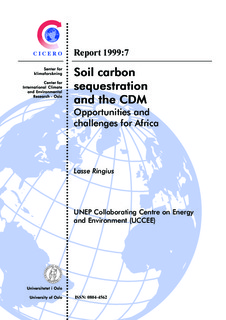Soil carbon sequestration and the CDM: Opportunities and the CDM
Research report
Permanent lenke
http://hdl.handle.net/11250/192060Utgivelsesdato
1999Metadata
Vis full innførselSamlinger
- CICERO Reports [210]
Sammendrag
The agriculture sector dominates the economies of most sub-Saharan countries, contributing about one-third of the region’s GDP, accounting for forty percent of the export, and employing about two-thirds of the economically active population. Moreover, some soils in sub-Saharan Africa could, by providing sinks for carbon sequestration, play an important role in managing global climate change. Improvements in agricultural techniques and land use practices could lead to higher agricultural productivity and accumulate soil carbon. Hence, soil carbon sequestration could produce local economic income as well as social and other benefits in Africa.
The Clean Development Mechanism (CDM) established in the 1997 Kyoto Protocol is designed to give developed countries with high domestic abatement cost access to low-cost greenhouse gas abatement projects in developing countries, and to benefit developing countries selling projects to investors in developed countries. It is presently unclear whether the CDM will provide credit for sink enhancement and permit broader sink activities. Unfortunately, few cost estimates of soil carbon sequestration strategies presently exist. While these costs are uncertain and all input costs have not been estimated, manure-based projects in small-holdings in Kenya could increase maize yield significantly and sequester one ton of soil carbon for a net cost of - US$806. Clearly, such projects would be very attractive economically.
There is presently an urgent need to launch useful long-term (>10 years) field experiments and demonstration projects in Africa. Existing data are not readily comparable, it is uncertain how large amounts of carbon could be sequestered, findings are site-specific, and it is unclear how well the sites represent wider areas. To develop CDM projects, it is important that experimental trials generate reliable and comparable data. Finally, it will be important to estimate local environmental effects and economic benefits, costs, and net costs of soil carbon sequestration projects.
